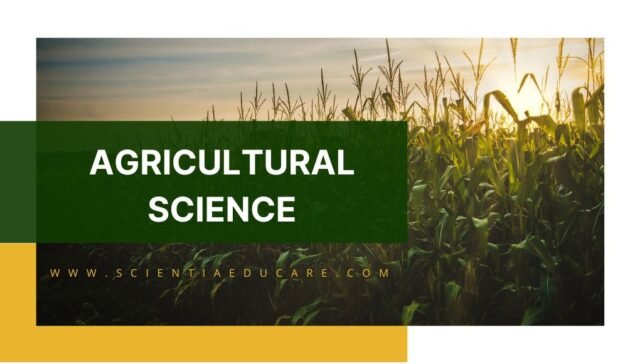Agricultural Science: Advanced Crop Production and Sustainable Management Strategies
Introduction
Agriculture is the backbone of human civilization, providing food, fiber, and fuel. Crop production and management involve scientific methods and strategies to enhance productivity while maintaining ecological balance. This study module explores various aspects of crop production, from soil preparation to sustainable agricultural practices.
Crop Production and Management,
Best soil for wheat farming,
Organic pest control in agriculture,
Efficient irrigation techniques for crops,
Crop rotation benefits for soil,
Sustainable farming methods for beginners
1. Understanding Crop Production
1.1 Definition of Crop Production
Crop production refers to the process of growing crops for food, fodder, fiber, and industrial purposes using various scientific and technological approaches.
1.2 Importance of Crop Production
- Ensures food security
- Supports the economy
- Provides raw materials for industries
- Creates employment opportunities
2. Essential Steps in Crop Production
2.1 Soil Preparation
- Tilling and Plowing: Loosens soil, enhances aeration, and removes weeds.
- Leveling: Helps distribute water evenly.
- Manuring: Enriches soil fertility.
2.2 Selection of Seeds
- Quality Seeds: Disease-resistant, high-yield varieties.
- Seed Treatment: Prevents fungal and bacterial infections.
2.3 Sowing Techniques
- Broadcasting: Spreading seeds manually.
- Drilling: Using machinery for even spacing.
- Transplanting: Shifting seedlings from nurseries to the field.
2.4 Irrigation Methods
- Traditional Methods: Wells, canals, tanks.
- Modern Methods: Drip irrigation, sprinkler irrigation.
2.5 Fertilization
- Organic Fertilizers: Compost, green manure, farmyard manure.
- Inorganic Fertilizers: Nitrogen, Phosphorus, Potassium (NPK) fertilizers.
2.6 Weed Control
- Manual Weeding: Using hand tools.
- Chemical Weeding: Herbicides.
- Biological Control: Using insects to control weed growth.
2.7 Pest and Disease Management
- Integrated Pest Management (IPM): Combination of biological, mechanical, and chemical methods.
- Common Pests: Aphids, locusts, caterpillars.
- Common Diseases: Blight, rust, wilt.
2.8 Harvesting and Storage
- Manual Harvesting: Using sickles, scythes.
- Mechanical Harvesting: Combines, threshers.
- Storage Techniques: Silos, granaries, refrigeration for perishable goods.
3. Sustainable Crop Management Practices
3.1 Crop Rotation
- Prevents soil depletion.
- Reduces pest infestations.
3.2 Organic Farming
- Uses natural fertilizers and pesticides.
- Promotes biodiversity.
3.3 Precision Farming
- Uses technology (GPS, sensors) to optimize inputs.
- Enhances productivity with minimal resource use.
3.4 Agroforestry
- Integrates trees with crops.
- Enhances soil health and biodiversity.
3.5 Conservation Tillage
- Reduces soil erosion.
- Improves water retention.
3.6 Greenhouse Farming
- Controls environmental conditions.
- Increases year-round productivity.
4. Technological Advancements in Crop Production
4.1 Use of Drones and AI
- Crop monitoring.
- Precision spraying of fertilizers and pesticides.
4.2 Hydroponics and Aeroponics
- Soil-less farming techniques.
- Efficient use of water and nutrients.
4.3 Genetic Engineering and Hybrid Crops
- Development of genetically modified (GM) crops.
- Disease-resistant and high-yield varieties.
5. Challenges in Crop Production
5.1 Climate Change Impacts
- Unpredictable weather patterns.
- Increased frequency of droughts and floods.
5.2 Soil Degradation
- Overuse of chemical fertilizers.
- Soil erosion due to deforestation.
5.3 Water Scarcity
- Over-extraction of groundwater.
- Pollution of water resources.
5.4 Market and Economic Issues
- Price fluctuations.
- Lack of access to credit and modern technologies.
6. Conclusion
The future of crop production lies in adopting sustainable and technologically advanced farming methods. Farmers must balance productivity with environmental conservation to ensure long-term agricultural success.
Relevant Website Links
For more information on agricultural science and crop production, visit:
- Food and Agriculture Organization (FAO)
- International Fund for Agricultural Development (IFAD)
- Indian Council of Agricultural Research (ICAR)
- United States Department of Agriculture (USDA)
Further Reading
- Sustainable Agriculture Research & Education (SARE)
- National Institute of Food and Agriculture (NIFA)
- World Bank Agriculture and Food
This study module provides an in-depth understanding of crop production and management, covering traditional practices, sustainable methods, and modern technological advancements.
Multiple-choice questions (MCQs) on ‘Agricultural Science: Crop Production and Management’
1. Which of the following is the first step in agricultural practices?
A) Sowing
B) Irrigation
C) Preparation of soil
D) Harvesting
Answer: C) Preparation of soil
Explanation: Before sowing seeds, the soil must be prepared by plowing, leveling, and adding manure to improve fertility.
2. Which type of crop is grown in the rainy season?
A) Rabi
B) Zaid
C) Kharif
D) None of the above
Answer: C) Kharif
Explanation: Kharif crops like rice, maize, and cotton are grown during the monsoon season (June–September).
3. Which of the following crops is a Rabi crop?
A) Wheat
B) Paddy
C) Maize
D) Jute
Answer: A) Wheat
Explanation: Rabi crops like wheat, barley, and mustard are sown in winter and harvested in summer.
4. Which agricultural tool is used for plowing?
A) Hoe
B) Sickle
C) Sprayer
D) Drip irrigation
Answer: A) Hoe
Explanation: A hoe is used for plowing, loosening soil, and removing weeds.
5. What is the process of loosening and turning the soil called?
A) Irrigation
B) Harvesting
C) Plowing
D) Weeding
Answer: C) Plowing
Explanation: Plowing aerates the soil, improves water retention, and helps root penetration.
6. Which of the following is an example of a leguminous plant?
A) Wheat
B) Pea
C) Rice
D) Cotton
Answer: B) Pea
Explanation: Leguminous plants like peas and beans fix atmospheric nitrogen through root nodules.
7. What is the main purpose of crop rotation?
A) Increasing soil erosion
B) Improving soil fertility
C) Reducing irrigation
D) Destroying soil microorganisms
Answer: B) Improving soil fertility
Explanation: Crop rotation prevents soil depletion and improves fertility by alternating nutrient-demanding and nitrogen-fixing crops.
8. Which method of irrigation conserves water the most?
A) Sprinkler system
B) Drip irrigation
C) Canal irrigation
D) Flood irrigation
Answer: B) Drip irrigation
Explanation: Drip irrigation delivers water directly to plant roots, minimizing wastage.
9. Which of the following is a natural fertilizer?
A) Urea
B) NPK
C) Compost
D) Superphosphate
Answer: C) Compost
Explanation: Compost is an organic fertilizer made from decomposed plant and animal waste.
10. The removal of unwanted plants from a field is known as:
A) Weeding
B) Sowing
C) Harvesting
D) Threshing
Answer: A) Weeding
Explanation: Weeding is necessary to prevent competition for nutrients, water, and sunlight.
11. Which type of soil is best suited for growing paddy?
A) Sandy soil
B) Loamy soil
C) Clayey soil
D) Rocky soil
Answer: C) Clayey soil
Explanation: Clayey soil has good water retention, which is ideal for rice cultivation.
12. Which component of the soil provides essential nutrients to plants?
A) Air
B) Humus
C) Sand
D) Gravel
Answer: B) Humus
Explanation: Humus enriches the soil with organic matter, improving fertility and water retention.
13. What is mixed cropping?
A) Growing one crop at a time
B) Growing two or more crops together
C) Growing crops with trees
D) None of the above
Answer: B) Growing two or more crops together
Explanation: Mixed cropping reduces the risk of crop failure and maximizes land use efficiency.
14. Which crop requires a large amount of water for growth?
A) Wheat
B) Rice
C) Cotton
D) Mustard
Answer: B) Rice
Explanation: Rice cultivation requires continuous water supply for proper growth.
15. What is the function of earthworms in agriculture?
A) Damage crops
B) Improve soil aeration
C) Cause soil erosion
D) Reduce soil fertility
Answer: B) Improve soil aeration
Explanation: Earthworms decompose organic matter and improve soil structure and fertility.
16. What is the full form of NPK in fertilizers?
A) Nitrogen, Phosphorus, Potassium
B) Nickel, Phosphorus, Krypton
C) Nitrogen, Potassium, Keratin
D) None of the above
Answer: A) Nitrogen, Phosphorus, Potassium
Explanation: NPK fertilizers provide essential macronutrients for plant growth.
17. Which of the following is a commercial crop?
A) Rice
B) Wheat
C) Cotton
D) Maize
Answer: C) Cotton
Explanation: Commercial crops like cotton and sugarcane are grown for sale rather than consumption.
18. Which microorganism is used in biofertilizers?
A) Bacteria
B) Virus
C) Fungus
D) Protozoa
Answer: A) Bacteria
Explanation: Nitrogen-fixing bacteria like Rhizobium improve soil fertility.
19. Which of the following is an oilseed crop?
A) Wheat
B) Maize
C) Groundnut
D) Barley
Answer: C) Groundnut
Explanation: Oilseed crops like groundnut and mustard are cultivated for extracting edible oil.
20. What is the term for growing crops without using synthetic chemicals?
A) Hybrid farming
B) Organic farming
C) Conventional farming
D) Genetic farming
Answer: B) Organic farming
Explanation: Organic farming uses natural fertilizers and pesticides for sustainable crop production.














